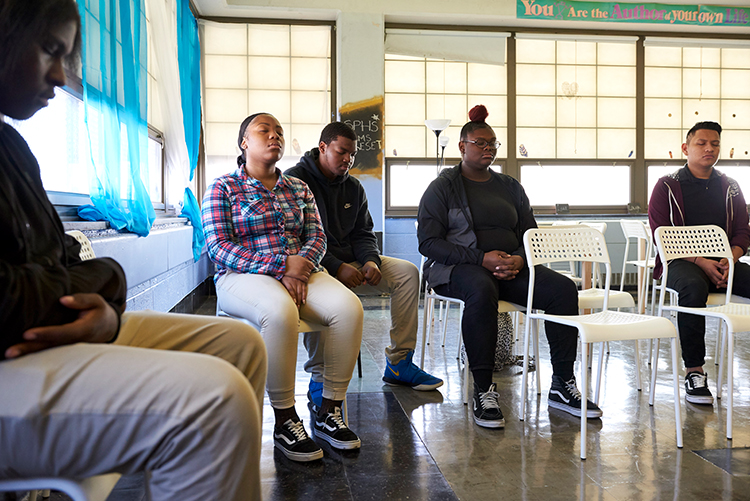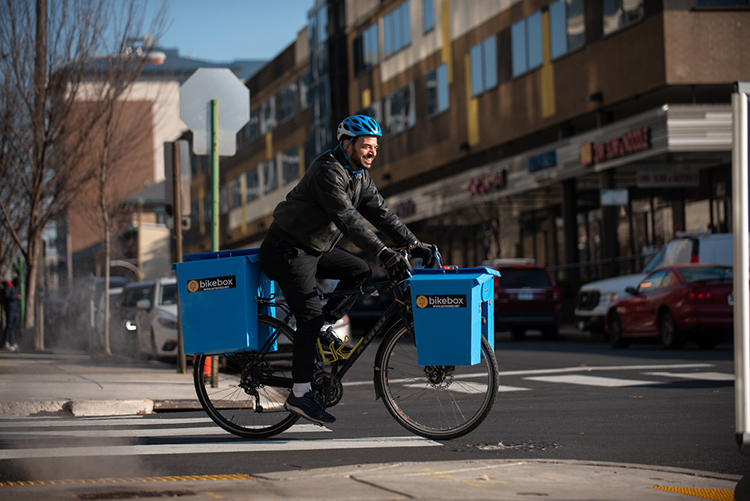Students at South Philadelphia High School meditate in the Re-Set Room. (Photo: Natalie Piserchio)
By Alexandra Wagner Jones
Quiet.
It’s a word you don’t often associate with high schools, where hallways and classrooms are usually bustling with the excited conversations of teens.
But Bodine High School in Northern Liberties is quiet. Very quiet. In the foreground is a class of 25 seniors who sit still, focusing on their breath. Eyes closed. Legs uncrossed. Hands resting calmly in their laps.
After a few seconds of stillness, a gentle voice cuts through the silence. The voice belongs to Julie Coopersmith, who is standing in the middle of the classroom in a blue shawl. In her hands, she holds a set of meditation chimes with three bells.
“The beautiful thing about mindfulness is you can’t get it wrong,” she says.
Looking out at the desks, arranged in a circle around her, she paces back and forth. One by one, she rings the bells, letting each chime fade across the room.
The first bell is to settle, she tells them. The second, to quiet the mind. The third, to focus. Through it all they must pay attention to the air their lungs are pumping in and out.
When her students breathe intentionally, they’re tapping into a part of the human nervous system called the parasympathetic nervous system, one of three divisions of the autonomic nervous system. Sometimes called the rest-and-digest system, the parasympathetic system conserves energy as it slows the heart rate, increases intestinal and gland activity, and relaxes sphincter muscles in the gastrointestinal tract.
“It’s responsible, dually, for focus and calm all at the same time,” she says. “It puts us in the present and it resets us.”
It’s the root of mindfulness meditation, a practice the Buddha began teaching 2,600 years ago to help people achieve clarity and peace of mind.
After three minutes, Coopersmith tells the students to open their eyes.
“Raise your hand if it feels a little quieter in here,” she says.
Every hand goes up.
All in Your Head
Amy Edelstein is the founder and executive director of the Inner Strength Foundation—a teen empowerment program currently operating in eight high schools, including Bodine, across Philadelphia that, according to its website, “aim[s] to support the youth of today through mindfulness and the perspective cultural development to be the great leaders of tomorrow.” This year, around 2,000 students will experience its curriculum.
Teens need the skills Inner Strength teaches for cultivating calmness and self-care more than ever, Edelstein says. Whatever’s going on in a student’s life—family hardships, standardized testing, bullying—can impact their ability to learn or even attend classes.
So stress management is crucial.
“Everybody thinks that there’s a system that everybody else has,” Edelstein says. But that’s not really the case.
Most struggle with the emotional weight of balancing social, academic and extracurricular commitments. Turning inward, they can start to understand the factors that shape their everyday lives and become interested in, rather than victimized by, their experiences.
Take Kaylah Santiago, a 17-year-old high school senior. As she applies for physical therapy programs this year, she’s enrolled in rigorous college-level courses, all while being a three-season athlete, playing soccer, basketball and softball.
Practicing mindfulness, she says, is something that’s making her senior year a little more manageable.
“It releases all your thoughts and… gives you a sense of relief,” she says.
Santiago’s favorite meditation so far is “the bubble method.” She describes it as closing her eyes, pretending all her stressful thoughts are in a bubble, and then letting them float away.
It’s a mechanism she can see herself using next year in college, where things will be new and probably hectic, she says.
Food for Thought
Back in class, Coopersmith is passing out Hershey Kisses. She gives each student a choice between milk and dark chocolate. For a student who doesn’t like chocolate, she offers a spoonful of raisins.
After dispensing the food, she asks a question.
“How much of what you do every day is brand new?” she asks. “Do you think it’s more than 50 percent?”
Most of the students nod.
“How do you stay engaged if everything is kind of the same?” Coopersmith continues.
She encourages them to think of it like watching a movie or reading a book more than once. A student named Summer pipes up.
“You can pay more attention to detail the second time,” she says.
“You gain more insight,” a student named Zieyra adds.
They’re about to find out, with a little more prompting, that Coopersmith thinks eating can be like that, too. She tells the students that they can find nuance and freshness in eating the same food—similar to revisiting a familiar book or movie.
She tells them that the latest research suggests people only really taste the first and last few bites of what they are eating. Coopersmith has them stare at the chocolate for a while.
“Take one bite,” she says. “Close your eyes and let it melt in your mouth.”
As they do, the students talk out of turn and laugh with each other. The idea of eating a piece of chocolate no bigger than a coin in 10 bites makes them giggle.
“What do you do in life that you just go through on autopilot?” she asks. “How do you take the same actions every single day and give a different perspective to it?”
Designed for the Mind
Edelstein began thinking about complex physics concepts before she was even in kindergarten. Her father, a particle physicist, would explain at the kitchen table to Edelstein and her siblings the process of searching for atomic particles and how everything was made up of them.
“I only really realized how much of an impact that had more recently,” she says.
She recalls pressing her little hand into the table, trying to figure out where the particles in the table ended and the ones in her hand began. If we’re all made up of the same thing, she thought, then objects aren’t really as fixed as we think of them being.
Everything is constantly moving. Constantly changing. Including people.
Especially teens.
This is where the idea to teach teens mindfulness stemmed from, she says. Their lives are in a state of flux as their self-image, interests and responsibilities shift. All this change causes stress. And teac
hing them methods to manage this stress can help them reckon with the emotions that come with it.
“The emphasis is on how to understand your experience in context,” Edelstein says.
Quieting their minds can help them take the time to think more clearly not just about their situations, but their identities as well.
“We’re made up of so many different qualities and experiences,” she says. “We show up so many different ways depending on the circumstance.”
Taking the Tools
When the school bell rings, students get up from their desks and begin to file out of the class—many handing Coopersmith homework assignments from the week before.
Her hope is that they use the tools she teaches outside of the classroom to destress, that these practices become a part of who they are, and they understand that their thoughts are not them—they get to pick and choose the thoughts they engage with.
“I can teach it, but they have to learn it, and then they have to practice it,” she says.
Over the last few years, she’s learned that kids are really interested in this kind of thing. They’re curious and ready to be empowered.
“Calling it mindfulness doesn’t give it [the credit] it deserves,” she says. “It’s not only mindfulness skills, it’s self-understanding.”








